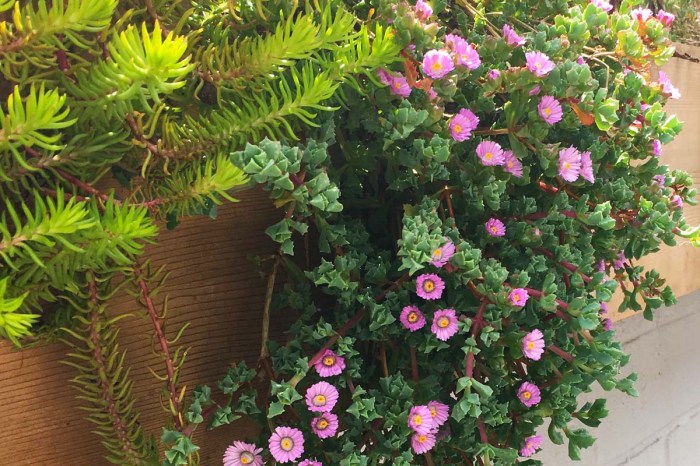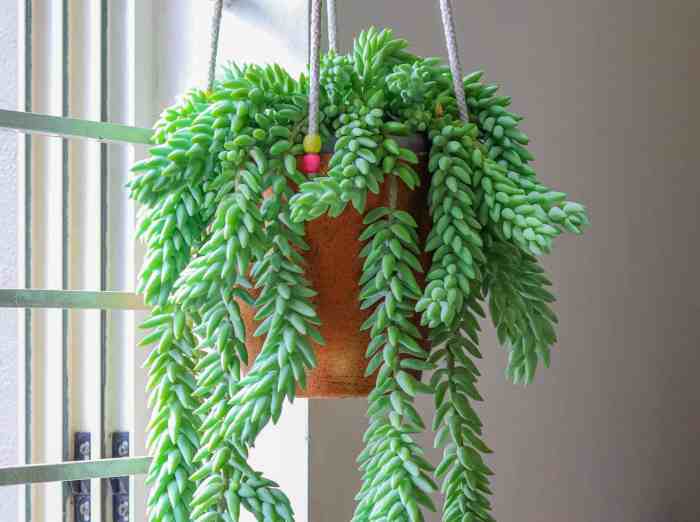Succulent trailing plants, with their captivating charm and cascading beauty, are gaining popularity as home decor enthusiasts seek unique and eye-catching additions to their living spaces. This comprehensive guide delves into the world of succulent trailing plants, exploring their varieties, care requirements, creative uses, and propagation techniques.
From the delicate strings of Sedum morganianum to the cascading rosettes of Echeveria elegans, succulent trailing plants offer a diverse range of textures, colors, and shapes that can transform any room into a vibrant oasis.
Popular Succulent Trailing Plant Varieties

Succulent trailing plants are a popular choice for gardeners due to their unique appearance and ease of care. These plants feature fleshy stems and leaves that store water, making them drought-tolerant and suitable for a variety of growing conditions.
There are numerous varieties of succulent trailing plants, each with its own distinct characteristics. Here is a comprehensive list of some of the most popular varieties:
Sedum
- Scientific name:Sedum spp.
- Common names:Stonecrop, sedum
- Characteristics:Sedums are a large and diverse group of succulents that come in a variety of shapes and sizes. They are typically low-growing and have fleshy leaves that are often arranged in rosettes. Sedums are known for their hardiness and ability to tolerate drought and neglect.
Senecio, Succulent trailing plants
- Scientific name:Senecio spp.
- Common names:String of pearls, string of bananas, senecio
- Characteristics:Senecios are a group of succulents that are characterized by their long, trailing stems. These stems are adorned with small, bead-like leaves that resemble pearls or bananas. Senecios are relatively easy to care for and make excellent hanging plants.
Delosperma
- Scientific name:Delosperma spp.
- Common names:Ice plant, delosperma
- Characteristics:Delospermas are a group of succulents that are native to South Africa. They are known for their ability to tolerate drought and heat. Delospermas have thick, fleshy leaves that are often arranged in rosettes. They produce colorful flowers that bloom in the spring and summer.
Lampranthus
- Scientific name:Lampranthus spp.
- Common names:Lampranthus, trailing ice plant
- Characteristics:Lampranthus are a group of succulents that are closely related to delospermas. They are also native to South Africa and share many of the same characteristics. Lampranthus have thick, fleshy leaves and produce colorful flowers. However, they are typically more compact than delospermas and are better suited for growing in containers.
Othonna
- Scientific name:Othonna spp.
- Common names:Othonna, little pickles
- Characteristics:Othonnas are a group of succulents that are native to South Africa. They are characterized by their small, cylindrical leaves that resemble pickles. Othonnas are relatively easy to care for and make excellent hanging plants.
Care and Maintenance for Trailing Succulents
Trailing succulents require specific care to thrive. Proper watering, sunlight, and soil composition are essential for their well-being.
Succulent trailing plants are a popular choice for hanging baskets due to their low maintenance requirements and ability to tolerate drought conditions. Many of these plants, such as the String of Pearls and Burro’s Tail, have long, trailing stems that can cascade over the sides of the basket, creating a lush and eye-catching display.
For more information on the best plants for hanging baskets indoors, including succulent trailing plants, visit this website .
Watering Frequency and Techniques
Water trailing succulents sparingly, allowing the soil to dry out completely between waterings. Overwatering can lead to root rot. When watering, soak the soil thoroughly and allow any excess water to drain away. Avoid getting water on the leaves, as this can promote fungal growth.
Sunlight Needs
Trailing succulents prefer bright, indirect light. They can tolerate some direct sunlight, but too much can scorch their leaves. If grown indoors, place them near a window that receives plenty of natural light.
Soil Composition and Drainage
Trailing succulents require well-draining soil. A mixture of cactus potting mix and perlite or pumice is ideal. The soil should be loose and allow water to drain away quickly.
Creative Uses for Trailing Succulents: Succulent Trailing Plants

Trailing succulents offer a plethora of creative opportunities for home decor, bringing a touch of greenery and visual appeal to various spaces. Their cascading stems and unique textures lend themselves to innovative displays, from vertical gardens to hanging baskets and tabletop arrangements.
Vertical Gardening
Trailing succulents excel in vertical gardening, creating living walls that transform bare spaces into vibrant green oases. They can be planted in wall-mounted planters or on trellises, allowing their stems to cascade gracefully. This technique not only saves space but also adds a touch of nature to urban environments.
Succulent trailing plants are a popular choice for indoor gardening due to their low-maintenance nature. For those looking for plants that can thrive in low-light conditions, indoor hanging plants that don’t need sun are an excellent option. Succulent trailing plants, such as string of pearls and burro’s tail, are known for their ability to tolerate low light and infrequent watering, making them ideal for busy individuals or those with limited natural light in their homes.
- Use a variety of trailing succulents with contrasting colors and textures for a visually stunning display.
- Consider using a mix of fast-growing and slow-growing species to create a dynamic effect.
- Provide adequate support for the succulent stems to prevent them from breaking.
Hanging Baskets
Hanging baskets are an excellent way to showcase the cascading beauty of trailing succulents. They can be suspended from ceilings, balconies, or porches, adding a touch of greenery to any outdoor or indoor space.
- Choose a basket with drainage holes to prevent waterlogging.
- Line the basket with a liner to retain moisture and prevent soil from spilling out.
- Use a potting mix specifically designed for succulents, which provides adequate drainage and aeration.
Tabletop Arrangements
Trailing succulents can also be incorporated into tabletop arrangements, adding a touch of elegance and whimsy to any surface. They can be placed in shallow dishes, terrariums, or even repurposed teacups.
- Consider using a mix of trailing succulents and other plants, such as air plants or ferns, for a more diverse display.
- Accessorize the arrangement with decorative elements, such as pebbles, crystals, or small figurines.
- Provide indirect sunlight or artificial light to ensure the succulents thrive.
Propagation Techniques for Trailing Succulents

Propagating trailing succulents allows you to increase your plant collection and share these unique varieties with others. Various methods are available, each with its own advantages and considerations.
Stem Cuttings
Stem cuttings involve taking a portion of a healthy stem from the mother plant and rooting it to create a new individual. To do this:
- Choose a healthy stem with several nodes (areas where leaves or roots form).
- Use a sharp, sterile knife or shears to cut a 3-4 inch section just below a node.
- Remove any leaves from the bottom inch or two of the cutting.
- Allow the cutting to dry for a few days to form a callus over the cut end.
- Plant the cutting in well-draining succulent soil, ensuring the callus is below the soil surface.
Leaf Cuttings
Leaf cuttings are a simple and effective method for propagating trailing succulents. The process involves:
- Selecting a healthy leaf from the mother plant.
- Twisting or gently pulling the leaf off at its base, ensuring a clean break.
- Allowing the leaf to dry for a few days to form a callus.
- Laying the leaf flat on well-draining succulent soil, with the callus side down.
- Lightly covering the leaf with soil or perlite to provide support.
Division
Division is a technique used to propagate trailing succulents that form clumps or rosettes. It involves separating individual rosettes or offsets from the main plant:
- Gently remove the succulent from its pot and loosen the soil around the roots.
- Identify individual rosettes or offsets that have their own root systems.
- Carefully separate the rosettes or offsets from the main plant using a sharp knife or shears.
- Replant the separated rosettes or offsets in their own containers with well-draining succulent soil.
Troubleshooting Common Problems with Trailing Succulents
Trailing succulents, with their graceful cascades of foliage, can be susceptible to specific issues. Identifying and addressing these problems promptly ensures healthy and thriving plants.
Overwatering
Excessive watering is a primary concern for trailing succulents. Their shallow root systems cannot absorb large amounts of water, leading to waterlogged soil and root rot. Symptoms include yellowing or brown leaves, soft stems, and stunted growth. To prevent overwatering, allow the soil to dry out completely between waterings and avoid misting or spraying the leaves.
Underwatering
While trailing succulents are drought-tolerant, prolonged periods of underwatering can also cause problems. Signs of underwatering include wilting leaves, wrinkled stems, and brown leaf tips. Water the succulents thoroughly when the soil is completely dry to the touch, ensuring the water reaches the roots.
Succulent trailing plants are a popular choice for indoor gardening, as they are easy to care for and can add a touch of greenery to any space. One of the best ways to display succulent trailing plants is in a hanging planter.
The umbra triflora hanging planter for window is a great option for this, as it is both stylish and functional. The planter is made of durable plastic and features a drainage hole to prevent overwatering. It also comes with a chain for easy hanging.
Succulent trailing plants are a great way to add a touch of nature to your home, and the umbra triflora hanging planter for window is the perfect way to display them.
Pests and Diseases
Trailing succulents can be affected by pests such as mealybugs, aphids, and scale insects. These pests feed on the plant’s sap, causing yellowing leaves, stunted growth, and honeydew secretion. Diseases like stem rot and fungal infections can also occur, leading to black or brown spots on the leaves and stems.
Regular inspection, isolation of infected plants, and appropriate treatment with insecticides or fungicides are essential to manage pests and diseases.
End of Discussion
Incorporating succulent trailing plants into your home decor not only adds aesthetic value but also brings a touch of nature indoors. Whether you choose to display them in hanging baskets, create vertical gardens, or arrange them on tabletops, these versatile plants will add a touch of whimsy and greenery to any space.
With proper care and attention, succulent trailing plants can thrive indoors, bringing joy and beauty for years to come. So, embrace the charm of these cascading wonders and let them enhance the ambiance of your living spaces.
Popular Questions
What are the most popular succulent trailing plant varieties?
Some of the most popular succulent trailing plant varieties include Sedum morganianum (Burro’s Tail), Senecio rowleyanus (String of Pearls), Echeveria elegans (Mexican Snowball), and Crassula pellucida (Calico Kitten).
How often should I water my succulent trailing plants?
Trailing succulents generally prefer infrequent watering. Allow the soil to dry out completely between waterings, and then water thoroughly until water drains from the drainage holes.
What type of soil is best for succulent trailing plants?
Succulent trailing plants thrive in well-draining soil. A cactus or succulent potting mix, or a mixture of regular potting soil and perlite or pumice, is ideal.